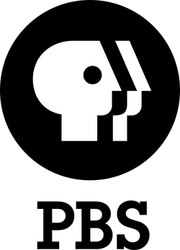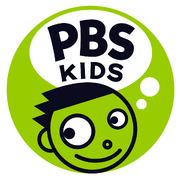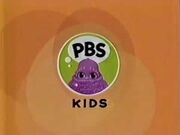



The Public Broadcasting Service (PBS) is a publicly funded, nonprofit television network based in the United States (Arlington, Virginia), and the most prominent public television provider in that region. PBS was given the American television rights to Boohbah in June 2003[1]; most PBS stations started broadcasting the show on January 19, 2004.
Boohbah was typically aired on the PBS Kids children's programming block, which had previously shown two other Ragdoll programs (Tots TV and Teletubbies). Because the typical American TV timeslot is ten minutes longer than that of the show, a half-hour version of the show was produced, with a total of the region's standard syndication number of 65 episodes adapted into this new formatting.
Boohbah was taken off the PBS Kids weekday lineup on PBS's national schedule in September 2006 to make room for Curious George, after which it remained as a weekend program until August 31, 2008. Locally, select stations had either dropped the show early or continued airing reruns until as late as early 2009 (when PBS's rights to Teletubbies and Boohbah expired)[2].
In addition to airing on regular PBS, Boohbah also aired on the original incarnation of the PBS Kids Channel and its replacement, PBS Kids Sprout, which was initially co-owned by PBS. Prior to nearly every station's adaption to a high-definition feed of their own programming, the nationally distributed PBS HD Channel had Boohbah as one of a few PBS Kids programs in their lineup.
Interstitial material
Idents and bumpers
Two character idents and one "coming up next" bumper related to Boohbah were produced. Most of PBS Kids' character-specific idents and bumpers would end with the - or one/some of the - main character[s] of the imminent show appearing inside either the block/channel's logo or a blank circle, respectively; the Boohbah interstitials had Zumbah appear inside the logo/circle.
Bubble
Dash, one of the block/channel's mascots, blows a large bubble, which he then touches and ends up inside. The bubble floats past the Eiffel Tower, the Great Wall of China, and the Statue of Liberty before a five-color rainbow streaks into the shot, forms a swirl, and irises in to reveal the PBS Kids logo amid a cream yellow background with many purple stars twirling inward.
Shadow Play

Dash makes numerous shadow puppets (like those of a bunny, a dog, an elephant, a dragon, and a robot) before making one of the PBS Kids logo.
Jack-in-the-Box
Dot (Dash's sister) cranks a jack-in-a-box, which shows various clips of Boohbah ("Are you ready to shake, twist, and dance? Boohbah is next, so put on your dancing pants!") before the jack pops out with a lollipop with Zumbah on it in his hand.
Promos
Although PBS does not air commercials in-between its programs, it does show promos for its shows, new episodes, and events. Two promos for Boohbah are known to exist, and they are listed here.
Website
The Boohbah microsite on PBS Kids' website was launched in December 2003. It featured the following activities:
Games
- Boohbah Dance: The player can make the Boohbahs dance around and stop them to make them perform different moves from "Whirly Weaving". This game is extremely similar to the dancing Boohbah game on boohbah.tv.
- Bubbles Bursting: This game is based on the Storyworld segment from the episode "Bubbles". The gameplay is very similar to the episode's main activity: When the bubble pump on the side of the screen blows a bubble the same color of each Boohbah out, the player must control the popper, a telescopic hand, and try popping it.
- Grandpappa and the Hammock: This game is, again, based on a Storyworld segment, this time from the episode "Hammock". The player must find an object to help Grandpappa get into the hammock.
- Kaleidoscope: This game is similar to a real kaleidoscope. By controlling the pink, purple, and orange levers on the sides of the kaleidoscope, the player can make different Boohbah patterns; the pink lever controls the Boohbahs' spinning, the purple lever shrinks or enlarges the Boohbahs, and the orange lever separates and connects the Boohbahs from each other.
- Boohbah Naming Game: This game's purpose is to memorize the names of each Boohbah; by moving the mouse around the screen, the Boohbahs' eyes will move, and if clicked, each Boohbah will say its name, move up, and light its eyebrows up.
- Squeaky Socks: This game is based on the Storyworld segment from the episode of the same title. The first part of the game is centered on coloring the sock, and if the Storyperson inside it is clicked, the sock will hop around.
- Windows: By opening each window, a different Storyperson will be revealed. This game is based on the Storyworld segment from "Big Windows".
- Storysheet: This game is a "create-your-own-environment" game featuring the Storypeople.
- Look What I Can Do!: This game is based on the US-only segment of the same name. Similar to Boohbah Dance, the player can program the dances they want their person to do, and if they click the "play" button, their person will do the dance that they made.
- Boohbah Patterns: This game allows the player to make their own pattern(s). Using the Boohball, and their mouse, they can change the color of the Boohbah(s) in their pattern, change it, or do both.
- Pearly Shells: This game is based on the episode of the same name. The player must find the pearl inside each shell, and if they do, Brother and Sister will do their "victory dance".
- Jumping Boohbahs: In this game, as the Boohbahs walk along the screen, the player must collect differently colored Boohballs; if they click on a Boohbah to make it jump and if it collects the right color ball, that Boohbah will say its name.
- Storypeople Matching Game: On the screen, a shadow of a Storyperson will pop up, encouraging the player to match the Storyperson to its shadow and say its name.
Non-flash games
If an user does not have Adobe Flash, they can access a non-Flash version of the website. This version excludes every game that requires Flash to be feasible, and leaves these slightly-altered games and activities alone:
- Boohbah Patterns
- Windows
- Storypeople Matching Game
- Boohbah Coloring and Print and Color: This is a activity where the user can color and then print out their Boohbah. There is also another activity which, in the style of a coloring book, the user can color in the Boohbah after they print it out.
- Storyworld Coloring and Print and Color
- Boohbah Pattern and Print: Using the arrows on the Boohbah's belly, the player can make multiple patterns and then print them out.
Parents and Teachers
Separate from the actual website, this section of the website informs adults about Boohbah, what the website has in store, and what activities they can do with their children/students.
- About the Program - This page tells the reader about the philosophy behind the show.
- Behind the Scenes in Storyworld - This page features information about the making of selected Storyworld segments, pictures of the particular segments, and the crew's experience shooting each segment.
- Program Description - This page tells the person roaming the website about 65 of the 104 episodes of Boohbah and also includes links to the activities related to the episode.
- FAQ - This section includes frequently asked questions about Boohbah, the answers to each of them, and information about the show.
- Activities
- Anne Wood Interview - This audio piece, which can also be heard on the interview bonus feature on each Boohbah DVD, tells people about the show's curriculum, and is synched to an animated video illustrating each of Anne Wood's points.
- Expert Q & A - Located on the main PBS Parents website, this section features questions from people visiting the Parents website and answers from Wood.
- A Boohbah Party - Also located on the Parents website, this section features stuff about making a Boohbah-themed birthday party, including the food, printables, and activities.
After over 9 years on the web, the site was officially removed in January 2013, four years after the show had stopped airing in the United States.